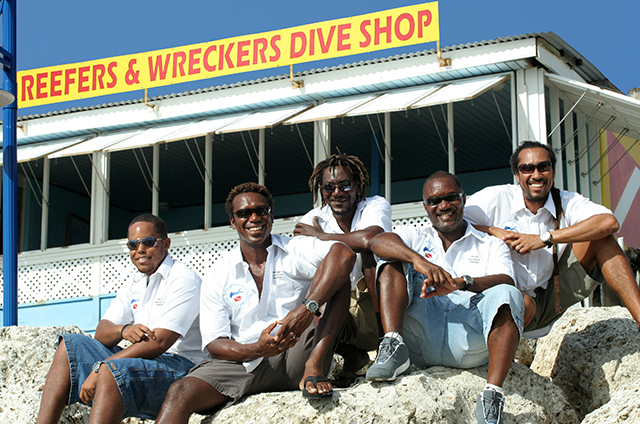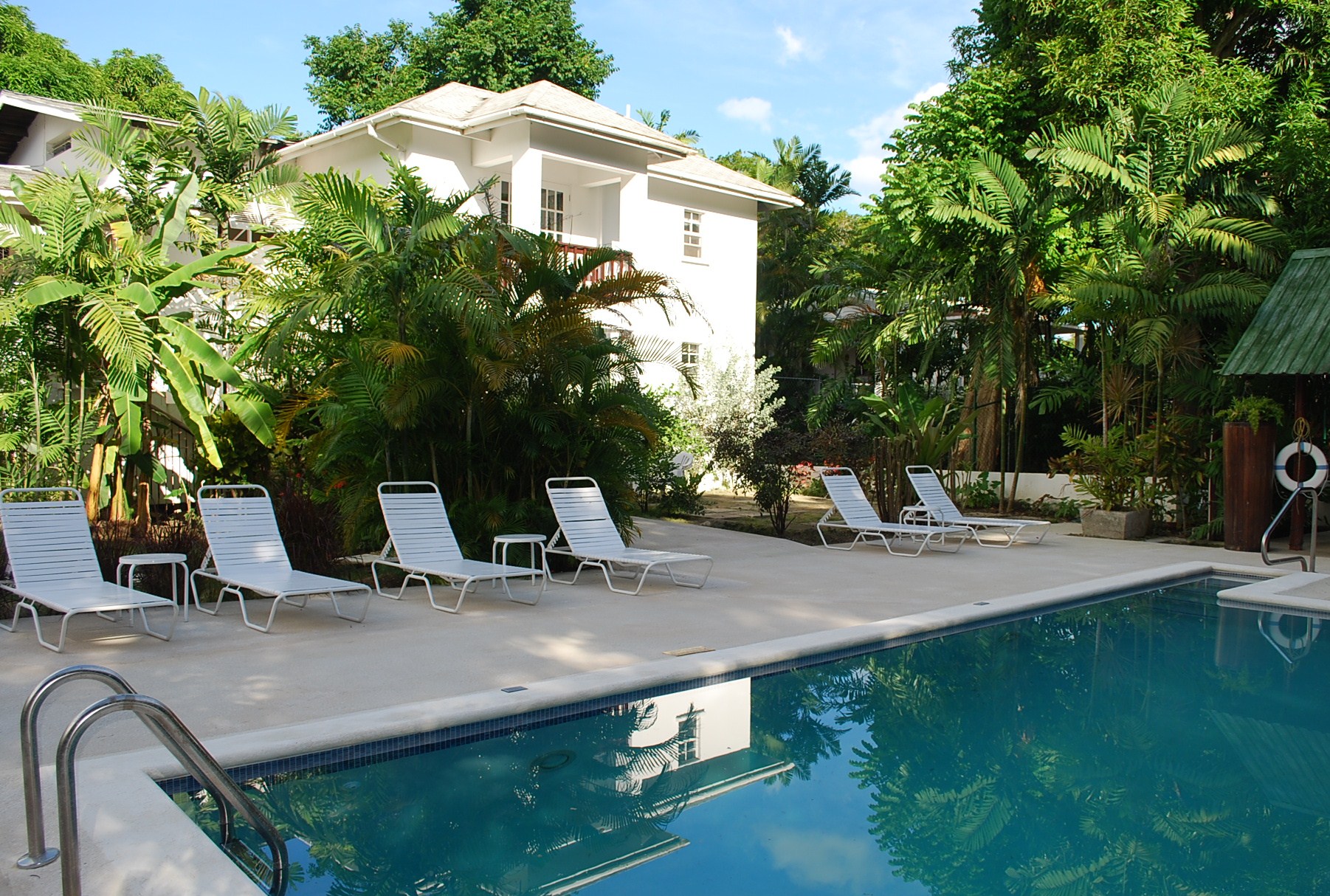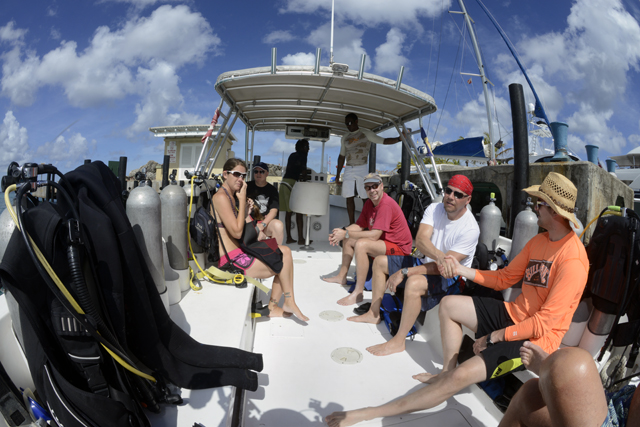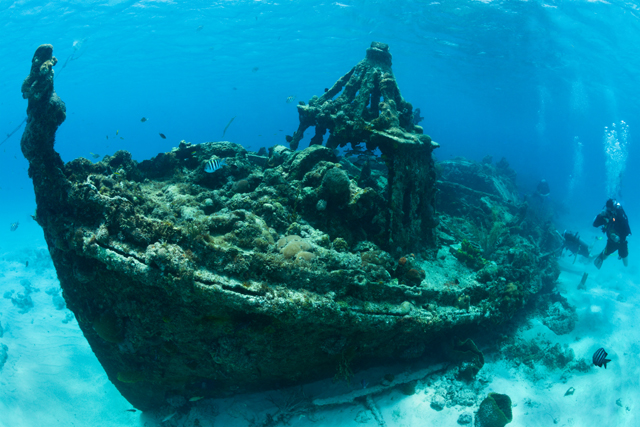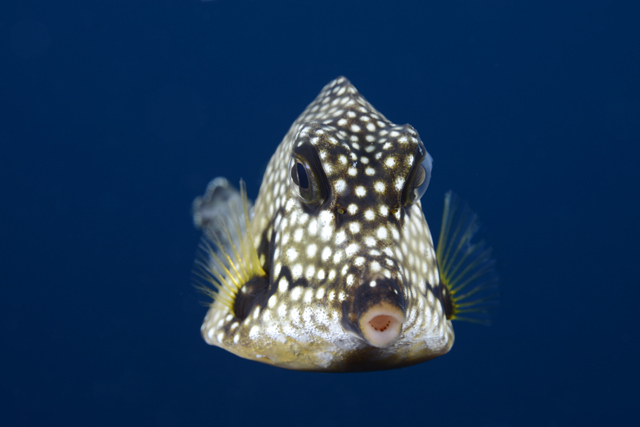News
Barbados: The Reefs, Wrecks and Critters of the North
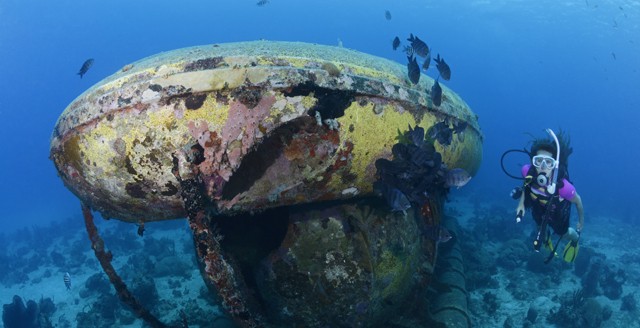
Barbados’s coastline offers a rich variety of dive sites from reefs to top notch shipwrecks. But most visiting divers are lured to the south end of the island and don’t venture very far north except for a dive on the world famous SS Stavronikita wreck, which I will discuss in more detail later. I met Michael Mahy, the owner of Reefers & Wreckers dive centre at the dive show in Birmingham. Mike assured me that the quieter north also had plenty to offer including more wrecks, dedicated macro sites and some ‘wilder’ dives on the exposed east coast. In an attempt to even the score I made arrangements to visit Mike’s dive centre just to see if he wasn’t spinning me a few porkies!
I had booked a room at Ascot House and Villas situated near Mullins. Ascot House can cater for up to 22 guests and would definitely be a good choice for groups or clubs. There is an onsite swimming pool and barbecue area – in fact, Mike invited me to a barbecue with his family and friends during my stay and it was the perfect ‘chill out’ spot. My ground floor room had a double bed with en-suite and there was a shared kitchen for making breakfast or evening meals. I managed to sneak a peek inside one of the villas and they really did look plush. The sandy beach at Gibbs bay is just a few minutes walk from Ascot House.
Reefers & Wreckers was opened by Mike and his father George in 1994. Phillip, Mike’s brother, joined them in 1999. It is presently located along the seafront at Speightstown in a traditional Barbadian building called Timothy House. Mike gave me a guided tour of the premises starting with the main front desk with seating area leading onto to an equipment storage room. Out the back there is a small courtyard for washing and drying equipment with showers and toilets. Upstairs consists of a bar overlooking the sea and a small classroom. Mike said that the bar wasn’t officially open but visiting groups could use the area for evening social events. At least I wouldn’t get hungry or thirsty. I could smell the bakery just across the road and the neighbouring cafe sells coffee and soft drinks so not a bad set up for divers.
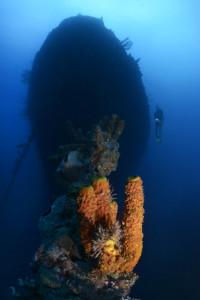
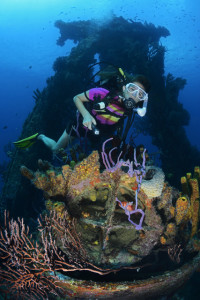 I counted 25 different dive sites on the wall map. All of the sites are located along the more protected west coast. Mike said that boat journeys varied from 5 to a maximum of 40 minutes. The shipwreck site at Carlisle Bay is the southernmost limit. The dive boats are moored at a marina which is 5 minutes drive from the centre. Reefers & Wreckers run 2 dive boats. I went out on Conqueror 1 which is a 10m long hull with twin 225hp outboards. The boat is basically open plan with a console area and benches down either side. Mike said the boat is good for up to 20 divers.
I counted 25 different dive sites on the wall map. All of the sites are located along the more protected west coast. Mike said that boat journeys varied from 5 to a maximum of 40 minutes. The shipwreck site at Carlisle Bay is the southernmost limit. The dive boats are moored at a marina which is 5 minutes drive from the centre. Reefers & Wreckers run 2 dive boats. I went out on Conqueror 1 which is a 10m long hull with twin 225hp outboards. The boat is basically open plan with a console area and benches down either side. Mike said the boat is good for up to 20 divers.
Mike tried to help me out with some modelling shots but I could see he wasn’t very comfortable with the job so I was more than happy when he introduced me to Kyle Siegel. Kyle worked as a captain’s PA on one of the big cruise ships. She had stopped off for a few days vacation and was even considering signing up for a PADI Divemaster course later in the year. I only had Miss Siegel’s help for 2 days so intended to make the most of it.
The wind had been blowing a hooley all night long which had brought in some extremely nasty floaties. The plan was to dive the Stavronikita wreck but when we arrived at the site the surface was awash with Portuguese man-o-war (Physalia physalis). I really wanted to get some decent pictures for my article and was willing to take the risk but then again I was wearing a full wetsuit for protection whereas Kyle just had a skimpy rash vest and shorts! We waited until the surrounding area was clear and made a jump for it. Kyle seemed more than happy to assist. I don’t think she realised what a Portuguese man-o-war was capable of doing but I took full advantage of the situation.
The SS Stavronikita is a 110m long Greek registered freighter sunk as an artificial reef project in 1978. There is quite an intriguing story surrounding her sinking. Apparently a fire had started in the engine room which quickly spread killing 6 of the crew. A big explosion followed which destroyed all means of communication so the ship drifted for several weeks eventually ending up in Barbadian waters. She was towed into harbour and left rotting for more than a year while insurance companies fought over the losses. Finally the government decided to sink her as a diver attraction. Initial plans were to sink her in shallower water but the anchors dragged just before the explosive charges went off. She now sits upright at a maximum depth of 40m just a few 100m from shore.
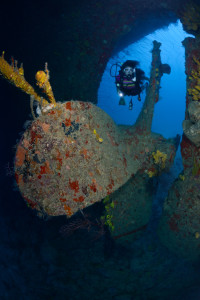
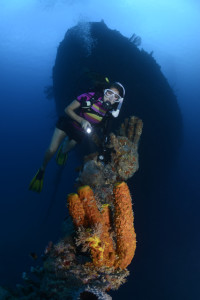 As we made our descent I could see the entire wreck laid out below me. I wanted to start our dive by the giant prop and then work our way forward to the square shaped mast. The idea was to get a shot of Kyle posing by the winch in the foreground with the mast swathed in purple gorgonians in the background. I could clearly see the dive boat on the surface while we were at deck level 23m below. We finished off our dive with a silhouette shot of the bow with Kyle in the foreground shining a torch on the anchor chain covered in orange tube sponges. This wreck has so many wide angle possibilities. On our ascent I kept a careful eye out for any signs of man-o-war but the surface was clear.
As we made our descent I could see the entire wreck laid out below me. I wanted to start our dive by the giant prop and then work our way forward to the square shaped mast. The idea was to get a shot of Kyle posing by the winch in the foreground with the mast swathed in purple gorgonians in the background. I could clearly see the dive boat on the surface while we were at deck level 23m below. We finished off our dive with a silhouette shot of the bow with Kyle in the foreground shining a torch on the anchor chain covered in orange tube sponges. This wreck has so many wide angle possibilities. On our ascent I kept a careful eye out for any signs of man-o-war but the surface was clear.
For our second dive Mike took us over to the Cement Pier. This dive site is literally 5 minutes boat ride from the marina. In my mind this is one of the best dives in Barbados, for macro and wide angle shots, all at a maximum depth of 15m. When there are no freighters loading or unloading divers are allowed underneath the pier. The huge pilings offer refuge for a multitude of big and small animals. I managed to do 3 dives under the giant pier legs and just couldn’t get enough of it. I got a great shot of Kyle in the foreground with the pier pilings silhouetted in the background like a giant spider. We found 2 hawksbills nibbling on the sponges and I even had a close encounter with a giant manta ray!
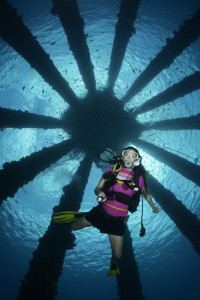
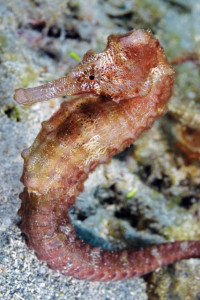 The seabed was a mess of old tyres and discarded metal but this provided homes for all sorts of macro life, including seahorses. Mike found 2 specimens within 5 minutes. I counted 20 good sized crayfish crammed inside a criss-cross of pilings. The place was absolutely buzzing. There were morays, flatfish, filefish, scorpions, trumpets, a variety of angels and butterflies, and much more. The only slight negative was the fact that any wayward fin kicks easily stirred up the sandy bottom causing some backscatter, but then again the current would take most of this away.
The seabed was a mess of old tyres and discarded metal but this provided homes for all sorts of macro life, including seahorses. Mike found 2 specimens within 5 minutes. I counted 20 good sized crayfish crammed inside a criss-cross of pilings. The place was absolutely buzzing. There were morays, flatfish, filefish, scorpions, trumpets, a variety of angels and butterflies, and much more. The only slight negative was the fact that any wayward fin kicks easily stirred up the sandy bottom causing some backscatter, but then again the current would take most of this away.
There were a number of PADI courses running during my visit. I spoke with Nick Davis who was on holiday with his family. His 2 daughters were finishing off their PADI open water courses. They had chosen to do the pool work and theory in the UK which just left the open water dives to do in the clear calm waters of Barbados.
During my stay Mike introduced me to a number of local bars and restaurants but they were fairly spaced out along the coastline so I would recommend hiring a car for a few days. The Fish Pot is located right by the beach. I thought the ambience was perfect for a romantic night out and my tuna steak was huge. The Ramshackle Bar and Restaurant in Saint James Parish was an excellent choice for burgers and wraps and still had a beachside outlook.
I wanted to explore the wilder dive sites on the north east coast but unfortunately the weather was against me. We went up as far as Maycocks Bay which has got a good reputation for big animal sightings. But on the day we had extremely poor visibility, around 5 metres, and the sea was a distinct shade of green instead of the usual hues of blue. We still managed to see an assortment of rays, barracuda and hawksbill turtles so I’m sure that on a good day this site delivers.
With my 2 Kyle days in the bank I had to settle back to scratching around for whatever photos I could get. Mike offers 2 tank morning dives which is ideal for divers with families or non-diving partners but not for stressed out photographers. We headed out to Great Ledge for a gentle drift dive. I had left my macro lens on hoping to get some more fishy shots. I closed in on a small hawksbill but noticed that one of its eyes had become diseased. It was understandably wary of me so I backed away and left it in peace. I then found the craziest boxfish I have ever encountered. This little boxfish darted straight for my camera port and wouldn’t leave it alone. I can only guess that the fish saw its own reflection in the glass and thought it was either a potential mate or a threat. Either way it came off the reef and stayed with me right up to safety stop depth.
The Pamir wreck turned out to be another favourite of mine. The 50m long freighter sits upright at a maximum depth of 20m deep and yet again is ideally situated less than 5 minutes boat ride from the marina. The v-shaped bow silhouetted against the anchor made a really nice composition. There was also a yellow mini submarine lying about 30m from the portside bow just to add some extra interest.
We ventured as far south as Carlisle Bay for the second dive. This really is a shipwreck playground with the remains of at least 6 wrecks to explore and all at a maximum depth of around 15 metres. The wrecks are diver friendly with easy access to all the compartments including the engine rooms.
All in all I had quite an action packed week and the torrential rain hadn’t managed to dampen my spirits. Mike showed me a good selection of dive sites that catered for all tastes from wrecks and reefs to dedicated macro. I could go back to the cement pier time and time again and never get bored. Mike said there were plans to make Ascot House an out and out dive resort sometime in the near future but this was still in the early stages of discussion. There could well be some exciting times ahead.
Information
Reefer & Wreckers
Tel: +1 246.422.5450
UK Bookings: 07834 5567777
Cell: +1 246.234.1377
Ascot House
Blogs
Northern Red Sea Reefs and Wrecks Trip Report, Part 3: The Mighty Thistlegorm

Jake Davies boards Ghazala Explorer for an unforgettable Red Sea diving experience…
Overnight, the wind picked up, making the planned morning dive a bit bumpy on the Zodiacs to the drop point on Thomas Reef. There, we would dive along the reef before descending through the canyon and then passing under the arch before ascending the wall with a gentle drift. The site provided great encounters with more pelagic species, including shoals of large barracuda, tuna, and bigeye trevally.
Once back on the boat, it was time to get everything tied down again as we would head back south. This time, with the wind behind us, heading to Ras Mohammed to dive Jackfish Alley for another great gentle drift wall dive before then heading up the coast towards the Gulf of Suez to moor up at the wreck of the Thistlegorm. This being the highlight wreck dive of the trip and for many onboard, including myself, it was the first time diving this iconic wreck. I had heard so much about the wreck from friends, and globally, this is a must on any diver’s list. Fortunately for us, there was only one other boat at the site, which was a rarity. A great briefing was delivered by Ahmed, who provided a detailed background about the wreck’s history along with all the required safety information as the currents and visibility at the site can be variable.

Kitting up, there was a lot of excitement on deck before entering the water and heading down the shoreline. Descending to the wreck, there was a light northerly current which reduced the visibility, making it feel more like the conditions that can be found off the Welsh coast. At 10m from the bottom, the outline of the wreck appeared as we reached the area of the wreck which had been bombed, as our mooring line was attached to part of the propeller shaft. Arriving on deck, instantly everywhere you looked there were many of the supplies which the ship was carrying, including Bren Carrier tanks and projectiles that instantly stood out.

We headed around the exterior, taking a look at the large propeller and guns mounted on deck before entering the wreck on the port side to take a look in the holds. It was incredible to see all the trucks, Norton 16H, and BSA motorcycles still perfectly stacked within, providing a real snapshot in time.

Overall, we had four dives on the Thistlegorm, where for all of the dives we were the only group in the water, and at times, there were just three of us on the whole wreck, which made it even more special, especially knowing that most days the wreck has hundreds of divers. Along with the history of the wreck, there was plenty of marine life on the wreck and around, from big green turtles to batfish, along with shoals of mackerel being hunted by trevally. Some unforgettable dives.

The final leg of the trip saw us cross back over the Suez Canal to the Gobal Islands where we planned to stay the night and do three dives at the Dolphin House for the potential of sharing the dive with dolphins. The site, which included a channel that was teeming with reef fish, especially large numbers of goatfish that swam in large shoals along the edge of the reef. These were nice relaxing dives to end the week. Unfortunately, the dolphins didn’t show up, which was okay as like all marine life they are difficult to predict and you can’t guarantee what’s going to be seen. With the last dive complete, we headed back to port for the final night where it was time to clean all the kit and pack before the departure flight the next day.

The whole week from start to finish on Ghazala Explorer was amazing; the boat had all the facilities you need for a comfortable week aboard. The crew were always there to help throughout the day and the chefs providing top quality food which was required after every dive. The itinerary providing some of the best diving with a nice mixture of wreck and reef dives. I would recommend the trip to anyone, whether it’s your first Red Sea liveaboard in the Red Sea or you’re revisiting. Hopefully, it’s not too long before I head back to explore more of the Red Sea onboard Ghazala Explorer.

To find out more about the Northern Red Sea reef and wrecks itineraries aboard Ghazala Explorer, or to book, contact Scuba Travel now:
Email: dive@scubatravel.com
Tel: +44 (0)1483 411590
Photos: Jake Davies / Avalon.Red
Blogs
Northern Red Sea Reefs and Wrecks Trip Report, Part 2: Wall to Wall Wrecks

Jake Davies boards Ghazala Explorer for an unforgettable Red Sea diving experience…
The second day’s diving was a day full of wreck diving at Abu Nuhas, which included the Chrisoula K, Carnatic, and Ghiannis D. The first dive of the day was onto the Chrisoula K, also known as the wreck of tiles. The 98m vessel remains largely intact where she was loaded with tiles which can be seen throughout the hold. The stern sits at 26m and the bow just below the surface. One of the highlights of the wreck is heading inside and seeing the workroom where the machinery used for cutting the tiles are perfectly intact. The bow provided some relaxing scenery as the bright sunlight highlighted the colours of the soft coral reef and the many reef fish.

Following breakfast, we then headed to the next wreck, which was the Carnatic. The Carnatic is an 89.9m sail steamer vessel that was built in Britain back in 1862. She ran aground on the reef back in 1869 and remains at 27m. At the time, she was carrying a range of items, including 40,000 sterling in gold. An impressive wreck where much of the superstructure remains, and the two large masts lay on the seafloor. The wooden ribs of the hull provide structures for lots of soft corals, and into the stern section, the light beams through, bouncing off the large shoals of glass fish that can be found using the structure as shelter from the larger predators that are found outside of the wreck.

The final wreck at Abu Nuhas was the Ghiannis D, originally called ‘Shoyo Maru,’ which was 99.5m long and built in Japan back in 1969 before becoming a Greek-registered cargo ship in 1980. The ship then ran aground on the reef on April 19th, 1983, and now sits at the bottom at a depth of 27m. Heading down the line, the stern of the ship remains in good condition compared to the rest of the hull. The highlight of the wreck, though, is heading into the stern section and down the flights of stairs to enter the engine room, which remains in good condition and is definitely worth exploring. After exploring the interior section of the ship, we then headed over to see the rest of the superstructure, where it’s particularly interesting to see the large table corals that have grown at the bow relatively quickly considering the date the ship sank. After surfacing and enjoying some afternoon snacks, we made sure everything was strapped down and secured as we would be heading north and crossing the Gulf of Suez, where the winds were still creating plenty of chop.

The next morning, it was a short hop to Ras Mohammed Nature Reserve for the next couple of days of diving. The 6am wake-up call came along with the briefing for the first site we would be diving, which was Shark & Yolanda. The low current conditions allowed us to start the dive at Anemone City, where we would drift along the steep, coral-filled wall. These dives involved drifts, as mooring in Ras Mohammed wasn’t allowed to protect the reefs. As a dive site, Shark & Yolanda is well-known and historically had a lot of sharks, but unfortunately not so many in recent years, especially not so early in the season. However, there was always a chance when looking out into the blue.

The gentle drift took us along the steep walls of the site, with plenty of anemone fish to be seen and a huge variety of corals. It wasn’t long into the dive before we were accompanied by a hawksbill turtle, who drifted with us between the two atolls before parting ways. Between the two reefs, the shallow patch with parts of coral heads surrounded by sand provided the chance to see a few blue-spotted stingrays that were mainly resting underneath the corals and are always a pleasure to see. With this being the morning dive, the early sunlight lit up the walls, providing tranquil moments. Looking out into the blue, there was very little to be seen, but a small shoal of batfish shimmering underneath the sunlight was a moment to capture as we watched them swim by as they watched us.

Towards the end of the dive, we stopped at the wreck of the Jolanda where the seafloor was scattered with toilets from the containers it was carrying. This provided a unique site to make a safety stop, which was also accompanied by a large barracuda slowly swimming by, along with a hawksbill turtle calmly swimming over the reef as the sun rays danced in the distance.
For the next dive, we headed north to the Strait of Tiran to explore the reefs situated between Tiran Island and Sharm El Sheik, which were named after the British divers who had found them. We started on Jackson before heading to Gordons Reef, where we also did the night dive. All the atolls at these sites provided stunning, bustling coral reefs close to the surface and steep walls to swim along, which always provided the opportunity to keep an eye out for some of the larger species that can be seen in the blue. Midwater around Jackson Reef was filled with red-toothed triggerfish and shoals of banner fish, which at times were so dense that you couldn’t see into the blue. Moments went by peacefully as we enjoyed the slow drift above the reef, watching these shoals swim around under the mid-afternoon sun.

The night dive at Gordon’s Reef was mainly among the stacks of corals surrounded by sand, which was great to explore under the darkness. After some time circling the corals, we came across what we were really hoping to find, and that was an octopus hunting on the reef. We spent the majority of the dive just watching it crawl among the reef, blending into its changing surroundings through changes in colour and skin texture. It’s always so fascinating and captivating to watch these incredibly intelligent animals, in awe of their ability to carry out these physical changes to perfectly blend into the reef. Before we knew it, it was time to head back to the boat to enjoy a well-deserved tasty dinner prepared by the talented chefs onboard.
Check in for the 3rd and final part of this series from Jake tomorrow!
To find out more about the Northern Red Sea reef and wrecks itineraries aboard Ghazala Explorer, or to book, contact Scuba Travel now:
Email: dive@scubatravel.com
Tel: +44 (0)1483 411590
Photos: Jake Davies / Avalon.Red
-

 News3 months ago
News3 months agoHone your underwater photography skills with Alphamarine Photography at Red Sea Diving Safari in March
-

 News3 months ago
News3 months agoCapturing Critters in Lembeh Underwater Photography Workshop 2024: Event Roundup
-

 Marine Life & Conservation Blogs2 months ago
Marine Life & Conservation Blogs2 months agoCreature Feature: Swell Sharks
-

 Blogs2 months ago
Blogs2 months agoMurex Resorts: Passport to Paradise!
-

 Blogs2 months ago
Blogs2 months agoDiver Discovering Whale Skeletons Beneath Ice Judged World’s Best Underwater Photograph
-

 Gear Reviews3 months ago
Gear Reviews3 months agoGear Review: Oceanic+ Dive Housing for iPhone
-

 Marine Life & Conservation2 months ago
Marine Life & Conservation2 months agoSave the Manatee Club launches brand new webcams at Silver Springs State Park, Florida
-

 News3 months ago
News3 months agoWorld’s Best Underwater Photographers Unveil Breathtaking Images at World Shootout 2023


